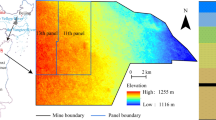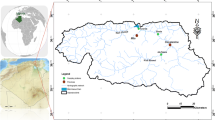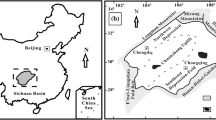Abstract
In order to study and prevent water hazards in coal mines under thick loose strata, we need to make correct assessments of their water abundance levels based on the limited borehole data. According to the multi-source information composite principle, five main influencing factors of water abundance are chosen, and they are: the aquifer thickness, the thickness ratio between sandy and clayey layers, the consumption of the drilling fluid, the core recovery rate, and the hydraulic conductivity. Their spatial variations in the whole study area could be inferred from Kriging interpolation. Next, we have developed a novel off-the-shelf two-step assessment approach. In the first step, we apply a dimensionality reduction technique called Fisher discriminant analysis (FDA) to project the original normalized data into a low-dimensional space, which is convenient for data visualization. In this projection process, we want to keep the original information as much as possible. In the second step, we train three classification algorithms on the same transformed low-dimensional data to predict the water abundance level, and leave-one-out cross-validation is used to validate our proposed method due to data sparsity. Finally, the comprehensive zoning map of the study area’s water abundance level is established, which can provide scientific guidance for the mining operations and prevention of mine water hazards in this region. The whole process is further elaborated through a case study of the Baodian coal mine, from which we are able to know the location with the highest water abundance level.









Similar content being viewed by others
References
Boyd S, Vandenberghe L (2004) Convex optimization. Cambridge University Press. https://web.stanford.edu/~boyd/cvxbook/
Chen W, Xie X, Wang J, Pradhan B, Hong H, Bui D T, Duan Z, Ma J (2017) A comparative study of logistic model tree, random forest, and classification and regression tree models for spatial prediction of landslide susceptibility. CATENA 151:147– 160
Chen L, Feng X, Xu D, Zeng W, Zheng Z (2018) Prediction of water inrush areas under an unconsolidated, confined aquifer: the application of multi-information superposition based on GIS and AHP in the Qidong coal mine, China. Mine Water Environ 37:786–795
Gao R, Yan H, Ju F, Mei X, Wang X (2018) Influential factors and control of water inrush in a coal seam as the main aquifer. Int J Min Sci Technol 28:187–193
Guo W, Zhao J, Yin L, Kong D (2017) Simulating research on pressure distribution of floor pore water based on fluid-solid coupling. Arab J Geosci 10
Hastie T, Tibshirani R, Friedman J (2009) The elements of statistical learning. Springer. https://web.stanford.edu/~hastie/ElemStatLearn/
Hou E, Tong R, Wang S, Feng J, Chen T (2016) Prediction method for the water enrichment of weathered bedrock based on fisher model in northern shaanxi jurassic coalfield. J Chin Coal Soc (Chin) 41:2312–2318
James G, Witten D, Hastie T, Tibshirani R (2013) An introduction to statistical learning with applications in R. Springer. https://www.statlearning.com/
Ke Q, Tian X, Bricker J, Tian Z, Guan G, Cai H, Huang X, Yang H, Liu J (2020) Urban pluvial flooding prediction by machine learning approaches a case study of Shenzhen city. China Adv Water Resour 145:103719
Li B, Zhang W, Ma L (2017) Influencing factors and prediction of mine water inrush disaster under thick unconsolidated layers and thin bedrock. J Shandong Univ Sci Technol (Nat Sci) (Chin) 36
Liu W, Li Q, Zhao J, Fu B (2018) Assessment of water inrush risk using the principal component logistic regression model in the Pandao coal mine. China Arab J Geosci 11
Liu W, Pang L, Xu B, Sun X (2020) Study on overburden failure characteristics in deep thick loose seam and thick coal seam mining. Geomatics Nat Hazards Risk 11:632–653
MathWorks (2021) Sample data sets. https://ww2.mathworks.cn/help/stats/sample-data-sets.html?lang=en
Meng Z, Li G, Xie X (2012) A geological assessment method of floor water inrush risk and its application. Eng Geol 143-144 :51–60
Mika S, Ratsch G, Weston J (1999) Fisher discriminant analysis with kernels. In: Neural Networks Signal Process. IX Proc. 1999 IEEE Signal Process. Soc. Work., pp 41–48
Naghibi S A, Hashemi H, Berndtsson R, Lee S (2020) Application of extreme gradient boosting and parallel random forest algorithms for assessing groundwater spring potential using DEM-derived factors. J Hydrol 589:125197
Ng A (2020) Stanford CS 229: Machine Learning lecture notes. http://cs229.stanford.edu/syllabus-spring2019.html
Panahi M, Sadhasivam N, Pourghasemi H R, Rezaie F, Lee S (2020) Spatial prediction of groundwater potential mapping based on convolutional neural network (CNN) and support vector regression (SVR). J Hydrol 588:125033
Phan T-T-H, Nguyen X H (2020) Combining statistical machine learning models with ARIMA for water level forecasting: The case of the Red river. Adv Water Resour 142:103656
Qian Z, Ren G, Chu F, Qin S (2016) Rock mass quality classification based on PCA and Fisher discrimination analysis. Rock Soil Mech. (in Chinese) 37
Qiao W, Howard K W F, Li W, Zhang S, Zhang X, Niu Y (2020) Coordinated exploitation of both coal and deep groundwater resources. Environ Earth Sci 79
Shao J, Zhang Q, Sun W, Wang Z, Zhu X (2020a) Numerical Simulation on Non-Darcy Flow in a Single Rock Fracture Domain Inverted by Digital Images. Geofluids 2020:1–13
Shao J, Zhang Q, Wu X, Lei Y, Wu X, Wang Z (2020b) Investigation on the Water Flow Evolution in a Filled Fracture under Seepage-Induced Erosion. Water 12(11):3188
Shao J, Zhang Q, Zhang W, Wang Z, Wu X (2021) Effects of the borehole drainage for roof aquifer on local stress in underground mining. Geomech Eng 24(5):479–490
Shi L, Gao W, Han J, Tan X (2017) A nonlinear risk evaluation method for water inrush through the seam floor. Mine Water Environ 36:597–605
Sugiyama M (2007) Dimensionality reduction of multimodal labeled data by local Fisher discriminant analysis. J Mach Learn Res 8:1027–1061
Wang H, Lu W (2020a) Recognizing groundwater DNAPL contaminant source and aquifer parameters using parallel heuristic search strategy based on Bayesian approach. Stoch Env Res Risk A
Wang Q, Dong S, Wang H, Yang J, Huang H, Dong X, Yu B (2020b) Hydrogeochemical processes and groundwater quality assessment for different aquifers in the Caojiatan coal mine of Ordos Basin, northwestern China. Environ Earth Sci 79
Wang Z, Zhang Q, Shao J, Zhang W, Wu X, Zhu X (2020c) New Type of Similar Material for Simulating the Processes of Water Inrush from Roof Bed Separation. ACS Omega 5(47):30405–30415
Wang Y, Yang W, Li M, Liu X (2012) Risk assessment of floor water inrush in coal mines based on secondary fuzzy comprehensive evaluation. Int J Rock Mech Min Sci 52:50–55
Wei J, Zhao Z, Xie D, Yu G, Wu X (2020) Water abundance evaluation of sandstone aquifer based on lithologic and structural characteristics. J Shandong Univ Sci Technol (Natural Sci) (in Chinese) 39
Wu Q, Wang M (2007) A framework for risk assessment on soil erosion by water using an integrated and systematic approach. J Hydrol 337:11–21
Wu Q, Fan Z, Zhang Z, Zhou W (2014) Evaluation and zoning of groundwater hazards in Pingshuo No. 1 underground coal mine, Shanxi Province, China. Hydrogeol J 22:1693–1705
Yadav B, Gupta P K, Patidar N, Himanshu S K (2020) Ensemble modelling framework for groundwater level prediction in urban areas of India. Sci Total Environ 712:135539
Yang C, Liu S, Liu L (2016) Water abundance of mine floor limestone by simulation experiment. Int J Min Sci Technol 26:495–500
Zhang J (2005) Investigations of water inrushes from aquifers under coal seams. Int J Rock Mech Min Sci 42:350–360
Zhang H, Wan Z, Ma Z, Zhang Y (2018a) Stability control of narrow coal pillars in gob-side entry driving for the LTCC with unstable overlying strata: a case study. Arab J Geosci 11
Zhang Q, Zhu H (2018b) Collaborative 3D geological modeling analysis based on multi-source data standard. Eng Geol 246:233–244
Zhang Q (2020a) Hydromechanical modeling of solid deformation and fluid flow in the transversely isotropic fissured rocks. Comput Geotech 128:103812
Zhang W, Zhang G, Li W, Hua X (2013) A model of Fisher’s discriminant analysis for evaluating water inrush risk from coal seam floor. J China Coal Soc (Chin) 38
Zhang W, Wang Z, Shao J, Zhu X, Li W, Wu X (2019) Evaluation on the stability of vertical mine shafts below thick loose strata based on the comprehensive weight method and a fuzzy matter-element analysis model. Geofluids
Zhang Q, Chen Y, Yang Z, Darve E (2020b) Multi-Constitutive Neural Network for Large Deformation Poromechanics Problem. arXiv:http://arxiv.org/abs/2010.15549
Zhang Q, Yan X, Shao J (2021) Fluid flow through anisotropic and deformable double porosity media with ultra-low matrix permeability: A continuum framework. J Pet Sci Eng 200:108349
Zhang W, Wang Z, Zhu X, Li W, Gao B, Yu H (2020c) A risk assessment of a water-sand inrush during coal mining under a loose aquifer based on a factor analysis and the Fisher model. J Hydrol Eng 25
Acknowledgments
This paper was supported by grants from the National Natural Science Foundation of China (51774199) and the Natural Science Foundation of Shandong Province for the support of major basic research projects (ZR2018ZC0740). The authors would like to sincerely thank the Yanzhou Coal Mining Company Limited for providing the hydrogeological data.
Author information
Authors and Affiliations
Corresponding author
Ethics declarations
Competing Interest
The authors declare that they have no known competing financial interests or personal relationships that could have appeared to influence the work reported in this paper.
Additional information
Communicated by: H. Babaie
Publisher’s note
Springer Nature remains neutral with regard to jurisdictional claims in published maps and institutional affiliations.
Appendix A: Original data
Appendix A: Original data
The Baodian coal mine has a geological type of thick loose strata and thin bedrock (Li et al. 2017). The water abundance of the lower group aquifer of this thick loose stratum has a significant impact on the actual coal mining process. Therefore, it is scientifically feasible to choose the Baodian coal mine as our study area. As a result, 30 samples are collected from the hydrogeological borehole data. The details are presented in the following Table 3, where “ID” denotes the corresponding borehole ID, “Th” denotes the aquifer thickness, “SC ratio” denotes the thickness ratio between sandy and clayey layers, Q represents the consumption of the drilling fluid, “Core” indicates the core recovery rate, and kh represents the hydraulic conductivity.
Rights and permissions
About this article
Cite this article
Zhang, Q., Wang, Z. Spatial prediction of loose aquifer water abundance mapping based on a hybrid statistical learning approach. Earth Sci Inform 14, 1349–1365 (2021). https://doi.org/10.1007/s12145-021-00640-3
Received:
Accepted:
Published:
Issue Date:
DOI: https://doi.org/10.1007/s12145-021-00640-3




